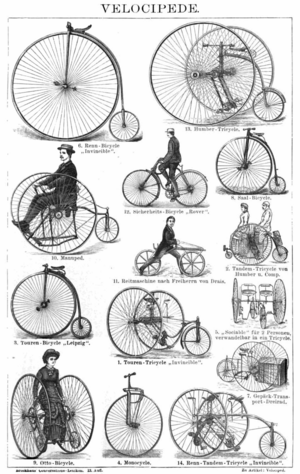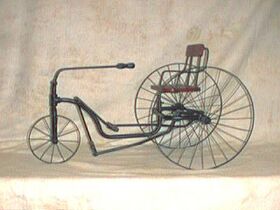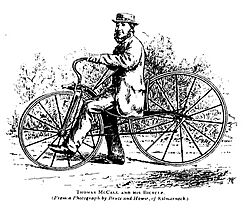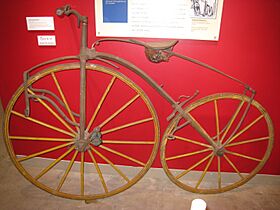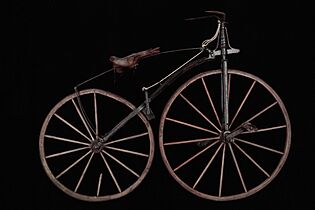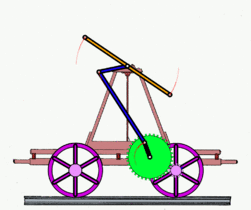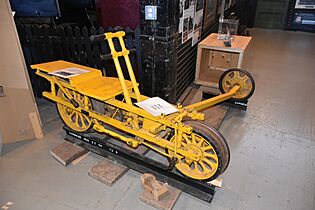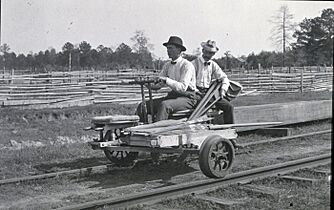Velocipede facts for kids
A velocipede is a vehicle that moves using human power and has one or more wheels. The most common type of velocipede we see today is the bicycle.
The word "velocipede" likely came from Karl von Drais. He used the French word vélocipède in 1817 for his invention, the Laufmaschine, also known as a 'dandy horse'. The word comes from Latin words meaning 'swift foot'. Today, 'velocipede' usually refers to the early versions of vehicles like the monowheel, unicycle, bicycle, tricycle, and quadracycle made between 1817 and 1880. It especially means the early bicycles that had pedals attached to the front wheel, before chains were invented.
Contents
The Story of Velocipedes
Early velocipedes came in many designs. Some had one, two, three, four, or even five wheels! Some two-wheeled ones had pedals on the front wheel. Three- and four-wheeled designs sometimes used foot pedals and levers to move the back wheels.
The first useful velocipede was made by Karl Drais in Germany. He called it a Laufmaschine, which means "running machine." He first rode it on June 12, 1817, and got a patent in 1818. This was the world's first balance bicycle. It quickly became popular in the UK and France. People called it a draisine, draisienne, vélocipède, swiftwalker, dandy horse (because fancy people called dandies loved it), or Hobby horse. It was made of wood and metal. Even with bumpy roads, people rode it for long distances.
It took almost 40 years for "velocipede" to become a common word. This happened when the first pedal-equipped bicycle was launched in the 1860s. Pierre Michaux, Pierre Lallement, and the Olivier brothers developed it. The Michaux company was the first to make many velocipedes, from 1857 to 1871. This French design was sometimes called the boneshaker. It was also made of wood, and later had metal tires. Riding it on cobblestone roads was very uncomfortable! These velocipedes became a popular trend. Big cities even had indoor riding schools, like roller rinks.
In the 1870s, new ways to work with metal led to the first all-metal velocipedes. The pedals were still on the front wheel. This wheel got bigger and bigger. Makers realized that a bigger wheel meant you could travel farther with one turn of the pedals. Solid rubber tires and long spokes on the big front wheel made the ride much smoother. This type of velocipede was the first to be called a bicycle. Its shape led to the nickname penny-farthing in the UK. Young men in the 1880s who could afford them loved these bikes.
While young men rode the high-wheeled bikes, ladies and older gentlemen like doctors preferred the safer tricycle in the 1880s. Many new ideas for tricycles later helped create the automobile. These included rack and pinion steering, the differential (which helps wheels turn at different speeds), and band brakes (early versions of drum brakes).
-
The American Velocipede, 1868, from Harper's Weekly
What Was a Boneshaker?
A boneshaker was a nickname from the 1860s for the first real bicycle with pedals. Manufacturers called them velocipedes. People called them "boneshakers" because they gave an extremely uncomfortable ride. This was due to their stiff wrought-iron frame and wooden wheels with iron tires.
Boneshaker History
This type of bicycle was invented in France in the 1860s. The Michaux company first made them from 1867 to 1869. This was when the first big bicycle craze happened. Many other companies copied the design. The boneshaker became less popular after the summer of 1869. In 1870, it was replaced by bicycles called "ordinary," "high-wheel," or "penny-farthing."
Boneshaker Design
The boneshaker was built much like the dandy horse. It had wooden wheels with iron tires and a frame made of wrought iron. As its name suggests, it was very uncomfortable. But a long, flat spring under the saddle helped a bit. This spring soaked up some of the bumps from rough roads. The boneshaker also had a brake. This was a metal lever that pushed a wooden pad against the back wheel. The front wheel axle had special bronze parts that were oiled to help them spin smoothly. Like the High Wheel bicycles that came later, boneshakers were front-wheel drive. But they had smaller wheels (only about 1 meter) and were heavy. A light model weighed about 14 kilograms or more.
-
A penny-farthing at the Estonian Sports and Olympic Museum in Tartu, Estonia.
Velocipedes on Railroads
Railroads in North America often used a three-wheeled vehicle. It was designed for one person to operate by hand. This vehicle became known as a "railway velocipede" or "railroad velocipede." George S. Sheffield invented this three-wheel hand-pump rail car.
The story goes that Sheffield lived far from train service. So, he built a simple three-wheel car to travel 7 miles between his home and work. One evening, while riding, he found a broken part of the track. He quickly warned a night freight train, stopping a possible accident. The railroad rewarded him by helping him make more of his invention. George Sheffield got the patent for his device in 1879. He called it a "velocipede hand car." The Sheffield velocipede was used until World War II.
-
A single-person railroad velocipede at the Toronto Railway Historical Association.
-
A velocipede or handcar at the Nevada State Railroad Museum
-
A velocipede at the Durango and Silverton Narrow Gauge Railroad Museum
-
A Sheffield velocipede at the Princeton Railroad Museum in Princeton, WV
See also
- Outline of cycling


